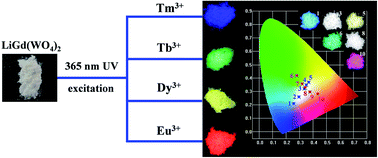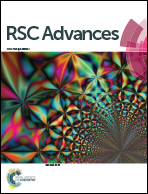Tunable white-light emission via energy transfer in single-phase LiGd(WO4)2:Re3+ (Re = Tm, Tb, Dy, Eu) phosphors for UV-excited WLEDs
Abstract
A series of novel single-phase color tunable LiGd(WO4)2(LGW):Re3+ (Re = Tm, Tb, Dy, Eu) phosphors have been synthesized by a solid-state reaction. X-ray diffraction (XRD), FT-IR, photoluminescence (PL) and fluorescence decay curves were utilized to characterize the as-prepared samples. Under the excitation of UV light, LGW:Tm3+, LGW:Tb3+, LGW:Dy3+ and LGW:Eu3+ exhibit the characteristic emissions of Tm3+ (blue), Tb3+ (green), Dy3+ (yellow) and Eu3+ (red), respectively. On the one hand, by simply adjusting the doping concentration of Eu3+ ions in the LGW:2% Tm3+, 4% Tb3+, x% Eu3+ system, a white emission in a single-phase was achieved by blending simultaneously the blue, green, and red emissions of Tm3+, Tb3+, and Eu3+ ions in the LGW host, in which the energy transfer from Tb3+ to Eu3+ ions was found to play an important role. On the other hand, a white emission can also be realized based on the energy transfer from Tm3+ to Dy3+ ions in the LGW:2% Tm3+, x% Dy3+ system. The energy transfer mechanism from Tm3+ to Dy3+ ions has been demonstrated to be through dipole–quadrupole interaction and the critical distance (RTm–Dy) calculated by the concentration quenching method is 16.03 Å. The PL properties of as-prepared materials indicate that LGW:Re3+ (Re = Tm, Tb, Dy, Eu) may be potentially applied as single-phase white-light-emitting phosphors for UV-excited WLEDs.


 Please wait while we load your content...
Please wait while we load your content...